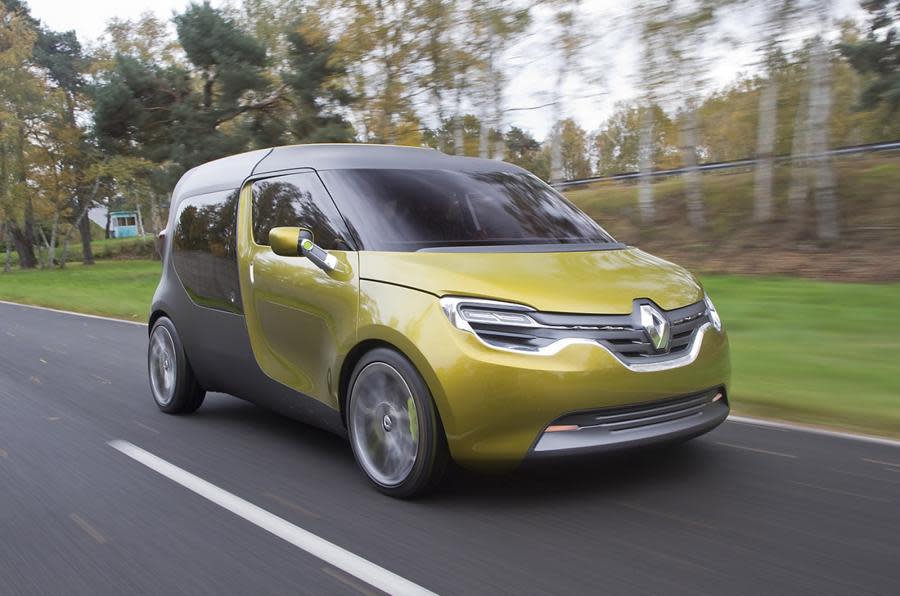Renault Frendzy 2011

The Renault Frendzy is the next link in the French firm's six-concept chain based on the human life cycle.
The striking DeZir electric gullwing coupe, the diesel-powered Renault Captur crossover and the petrol-engined sports-MPV R-Space represented ‘love’, ‘journey’, and ‘family’ respectively, while the asymmetrical zero-emissions wonder we see here is the Frendzy, said to represent ‘work’.
Renault’s concept series will lead us around an emotive colour chart of ‘simple’, ‘sensuous’ and ‘warm’ tones, all designed to appeal to our human side, but there’s more than just pie-in-the-sky on offer here. For starters, the Frendzy’s dichotomy of work-focused utilitarianism and family-friendliness apes the current Kangoo, and when it’s facelift time for that popular MPVan, the slightly squat, smoothly sculpted Frendzy (with its oversized Renault diamonds) will to some degree provide the aesthetic tuning fork.
There are also a host of innovations on the Frendzy that could realistically reach production in the not-too-distant future, while the launch of the electric Kangoo van later this month will test the basic formula in the real world.
Straight off it’s worth bearing with the proliferation of touchy-feely buzzwords above. It’s easy to become jaded by inverted commas used when describing concept cars, English words often seemingly scattered at random as on a Japanese schoolgirl’s pencil case. But with the Frendzy, Renault has created a genuinely emotive product out of what is, essentially, a van with extra seats.
There is indeed warmth in the pale green and matte grey bodywork, while synthetic materials are used to recreate organic-feeling interior panels such as plastic floor and seat-back mouldings that genuinely look and feel like weathered hardwood, and faux leather interwoven with metal strands to hatch patchwork seat cushions.
Renault’s design director for concept and show cars Axel Breun is quick to point out that modern production methods make such finishes relatively inexpensive, and can lend sophistication without the pricey inference of luxury. In other words, it doesn’t have to look ugly to be affordable and rugged.
Breun confirms that the tablet integration featured on the Frendzy is scheduled for production sooner rather than later, allowing connectivity and processing power on the move, while other innovations may be further off but will become more affordable, and therefore more likely to hit the options list, with time.
The current Kangoo’s innovative overhead parcel shelf could be optionally switched for the Frendzy’s fabric roof. It’s a fixed covering that stretches to allow awkward loads a few extra inches here and there. Likewise the radio transponder sensors in the boot frame record incoming and outgoing cargo; ballast which itself can be invisibly tethered via the magnetic floor.
More complex but still very possible would be the application of the Frendzy’s split tailgate, the lower part of which is a rectangular panel that electrically slides outwards then down to a parallel position, allowing easy access to the flat floor in a very compact arrangement. Perhaps less realistic is the 37in TV screen integrated with the sliding door, but at least the Frendzy shows it can be done tidily.
On the downside, the Frendzy misses out on the Kangoo’s flat floor when the rear seats (numbering two on a solid bench, as opposed to the Kangoo’s splitting row of three) are folded down, as the rear half of the interior is forced upwards by the Lithium-ion battery pack underneath, slashing maximum storage space by more than 20 percent. However, the production Kangoo ZE van is packaged to accommodate batteries without affecting load space, so it can be done, and the Frendzy’s slightly compromised layout does allow an incredibly elegant mechanism to stow the rear seats. Now you see them, now you don’t. Really.
The car’s asymmetry is also a stumbling block to production: a sliding rear passenger-side door opposite a suicide-style driver-side door (both pillar-less) would be an engineering nightmare in such a value-driven segment, especially considering the added complication of effecting an architectural about-face for us right-hookers. Finally, there’s neither boot partition nor glazing aft of the middle, further hindering practicality.
Our brief drive in the Frendzy revealed tramlining from the unassisted steering and chunky 19in wheels, scuttle shake, rumble, body roll, anaemic brakes and whining from the motor. But with the comfortable driving position (adjusted by moving the steering wheel and pedals around the fixed driver’s seat), lofty view and airy cockpit, it was easy to mentally reconcile the sophisticated driving environment with the soothing progress a properly-fettled zero-emissions descendant might offer.
It’s extremely unlikely Renault would give up the Frendzy for the £1million it cost to build, but looking beyond that abstract question, there are facets of the concept that could make your life easier, and perhaps more fun, which are strong selling points.
The Frendzy as-is, even dynamically sorted and toughened up for daily use, would clearly have very niche appeal, and there’s no game-changing packaging trickery in evidence, but the myriad innovations and potentially inexpensive sophistication it could bring to the MPV segment, electric or otherwise, are truly exciting.
]]>

 Yahoo Autos
Yahoo Autos 